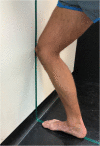Associations of foot and ankle characteristics with knee symptoms and function in individuals with patellofemoral osteoarthritis
- PMID: 32967701
- PMCID: PMC7509922
- DOI: 10.1186/s13047-020-00426-8
Associations of foot and ankle characteristics with knee symptoms and function in individuals with patellofemoral osteoarthritis
Abstract
Background: Foot and ankle characteristics are associated with patellofemoral pain (PFP) and may also relate to patellofemoral osteoarthritis (PFOA). A greater understanding of these characteristics and PFOA, could help to identify effective targeted treatments.
Objectives: To determine whether foot and ankle characteristics are associated with knee symptoms and function in individuals with PFOA.
Methods: For this cross-sectional study we measured weightbearing ankle dorsiflexion range of motion, foot posture (via the Foot Posture Index [FPI]), and midfoot mobility (via the Foot Measurement Platform), and obtained patient-reported outcomes for knee symptoms and function (100 mm visual analogue scales, Anterior Knee Pain Scale [AKPS], Knee injury and Osteoarthritis Outcome Score, repeated single step-ups and double-leg sit-to-stand to knee pain onset). Pearson's r with significance set at p < 0.05 was used to determine the association between foot and ankle charateristics, with knee symptoms and function, adjusting for age.
Results: 188 participants (126 [67%] women, mean [SD] age of 59.9 [7.1] years, BMI 29.3 [5.6] kg/m2) with symptomatic PFOA were included in this study. Lower weightbearing ankle dorsiflexion range of motion had a small significant association with higher average knee pain (partial r = - 0.272, p < 0.001) and maximum knee pain during stair ambulation (partial r = - 0.164, p = 0.028), and lower scores on the AKPS (indicative of greater disability; partial r = 0.151, p = 0.042). Higher FPI scores (indicating a more pronated foot posture) and greater midfoot mobility (foot mobility magnitude) were significantly associated with fewer repeated single step-ups (partial r = - 0.181, p = 0.023 and partial r = - 0.197, p = 0.009, respectively) and double-leg sit-to-stands (partial r = - 0.202, p = 0.022 and partial r = - 0.169, p = 0.045, respectively) to knee pain onset, although the magnitude of these relationships was small. The amount of variance in knee pain and disability explained by the foot and ankle characteristics was small (R2-squared 2 to 8%).
Conclusions: Lower weightbearing ankle dorsiflexion range of motion, a more pronated foot posture, and greater midfoot mobility demonstrated small associations with worse knee pain and greater disability in individuals with PFOA. Given the small magnitude of these relationships, it is unlikely that interventions aimed solely at addressing foot and ankle mobility will have substantial effects on knee symptoms and function in this population.
Trial registration: The RCT was prospectively registered on 15 March 2017 with the Australia and New Zealand Clinical Trials Registry ( ANZCTRN12617000385347 ).
Keywords: Foot; Function; Osteoarthritis; Pain; Patellofemoral.
Conflict of interest statement
The authors declare they have no competing interests.
Figures
Similar articles
-
Foot and ankle characteristics and dynamic knee valgus in individuals with patellofemoral osteoarthritis.J Foot Ankle Res. 2018 Dec 11;11:65. doi: 10.1186/s13047-018-0310-1. eCollection 2018. J Foot Ankle Res. 2018. PMID: 30559838 Free PMC article. Clinical Trial.
-
The immediate effects of foot orthoses on hip and knee kinematics and muscle activity during a functional step-up task in individuals with patellofemoral pain.Clin Biomech (Bristol). 2014 Nov;29(9):1056-62. doi: 10.1016/j.clinbiomech.2014.08.005. Epub 2014 Aug 23. Clin Biomech (Bristol). 2014. PMID: 25441771
-
Immediate effects of foot orthoses on lower limb biomechanics, pain, and confidence in individuals with patellofemoral osteoarthritis.Gait Posture. 2020 Feb;76:51-57. doi: 10.1016/j.gaitpost.2019.10.019. Epub 2019 Oct 24. Gait Posture. 2020. PMID: 31731134 Clinical Trial.
-
Effects of foot orthoses application during walking on lower limb joint angles and moments in adults with flat Feet: A systematic review with Meta-Analysis.J Biomech. 2024 Nov;176:112345. doi: 10.1016/j.jbiomech.2024.112345. Epub 2024 Sep 25. J Biomech. 2024. PMID: 39353247
-
The symptoms of osteoarthritis and the genesis of pain.Rheum Dis Clin North Am. 2008 Aug;34(3):623-43. doi: 10.1016/j.rdc.2008.05.004. Rheum Dis Clin North Am. 2008. PMID: 18687276 Free PMC article. Review.
Cited by
-
Supinated Foot Posture Is Associated With Reduced Knee and Foot Function in Patients With Knee Osteoarthritis.Cureus. 2025 Jun 1;17(6):e85201. doi: 10.7759/cureus.85201. eCollection 2025 Jun. Cureus. 2025. PMID: 40600101 Free PMC article.
-
Relationship between bilateral symmetry of foot posture and lower limb musculoskeletal injuries among workers engaged in physically demanding occupations: A cross-sectional investigation.Mechanobiol Med. 2024 Oct 1;3(1):100098. doi: 10.1016/j.mbm.2024.100098. eCollection 2025 Mar. Mechanobiol Med. 2024. PMID: 40396133 Free PMC article.
References
-
- van Middelkoop M, Bennell KL, Callaghan MJ, Collins NJ, Conaghan PG, Crossley KM, et al. International patellofemoral osteoarthritis consortium: consensus statement on the diagnosis, burden, outcome measures, prognosis, risk factors and treatment. Semin Arthritis Rheum. 2017;47:666–675. doi: 10.1016/j.semarthrit.2017.09.009. - DOI - PubMed
Publication types
MeSH terms
Grants and funding
LinkOut - more resources
Full Text Sources
Medical



